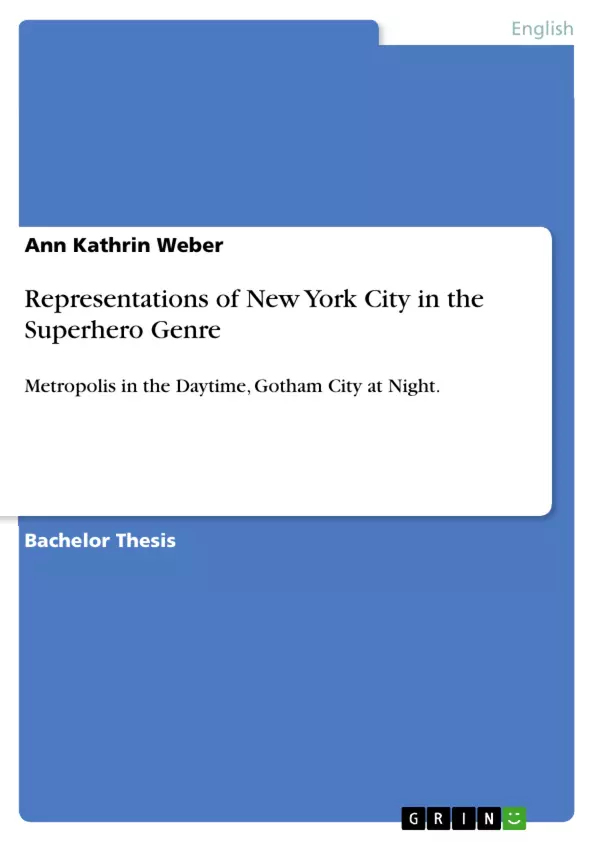This paper attempts to provide a scholarly analysis of the discussion triggered by Frank Miller’s comment that “Metropolis is New York in the daytime; Gotham City is New York at night.” The paper aims to analyze the representation of Gotham City in Nolan’s "The Dark Knight" trilogy and the representation of Metropolis as fictional version of New York City in selected episodes of the television series "Smallville." Starting from a disambiguation of the respective city’s name, it continues with an analysis of the resulting relation of factual and imagined place. In the following,the author discusses the possibility of understanding the cities, both Gotham City and Metropolis, as characters within the framework of the respective superhero narrative. To do so, three different theories of space and spatial practices are being introduced: Michel Foucault’s “Of Other Spaces: Utopias and Heterotopias” (1984), Henri Lefebvre’s The Production of Space (1991), and Michel de Certeau’s The Practices of Everyday Life (1984). These theories and their respective approaches to space, as contradictory as they might seem, open up various ways to discuss the city as character.
Table of Contents
- Introduction
- He Said, She Said
- As the Names Imply?
- Some Frenchmen in New York City
- Michel Foucault “Of Other Spaces: Utopias and Heterotopias” (1984)
- Henri Lefebvre The Production of Space (1991)
- Michel de Certeau The Practices of Everyday Life (1984)
- Conclusion
Objectives and Key Themes
This paper aims to provide a scholarly analysis of the representation of Gotham City in Nolan's The Dark Knight trilogy and the representation of Metropolis in selected episodes of the TV series Smallville. The paper will focus on the discussion sparked by Frank Miller's statement that "Metropolis is New York in the daytime; Gotham City is New York at night," investigating how these fictional cities are portrayed as representations of New York City and how their relationship to the actual city influences the narratives of their respective superhero series.
- The representation of Gotham City and Metropolis as fictional versions of New York City
- The relationship between fictional and actual city space
- The possibility of understanding Gotham City and Metropolis as characters in their respective superhero narratives
- The role of space as an active participant in the superhero narrative
- The potential for Gotham City and Metropolis to be considered active protagonists alongside the superheroes themselves
Chapter Summaries
- Introduction: This chapter introduces the topic of the paper by discussing Frank Miller's comment about Gotham City and Metropolis, which ignited discussions about their relationship to New York City. The paper will analyze the representation of these two cities in the Dark Knight trilogy and Smallville, focusing on their spatial relationship and their role as characters within the superhero narratives.
- He Said, She Said: This chapter explores the historical context of the discussion surrounding Gotham City and Metropolis, focusing on the origins of these cities within the DC Universe. The chapter will analyze how the cities are often presented as 'other spaces' linked to the construction of the American city, highlighting the importance of understanding their spatial characteristics within a broader context.
- As the Names Imply?: This chapter examines the representation of Gotham City and Metropolis in both comics and film, exploring their connection to New York City and the ways in which their portrayal influences the narratives of Batman and Superman. The chapter will delve into the specific spatial elements of the cities, analyzing their physical characteristics and their relationship to the surrounding areas.
- Some Frenchmen in New York City: This chapter introduces three theoretical approaches to space and spatial practices: Michel Foucault's "Of Other Spaces: Utopias and Heterotopias," Henri Lefebvre's The Production of Space, and Michel de Certeau's The Practices of Everyday Life. These theories will be used to analyze Gotham City and Metropolis as characters, providing different perspectives on their spatial qualities and their roles in the superhero narratives.
Keywords
This paper explores the representation of Gotham City and Metropolis as fictional versions of New York City. It analyzes their spatial characteristics, their relationship to the real city, and their roles as characters within the superhero narratives. Key concepts include: Gotham City, Metropolis, New York City, space, spatial practices, superhero narrative, character, protagonist, DC Universe, The Dark Knight trilogy, Smallville.
- Quote paper
- Ann Kathrin Weber (Author), 2014, Representations of New York City in the Superhero Genre, Munich, GRIN Verlag, https://www.grin.com/document/274285



